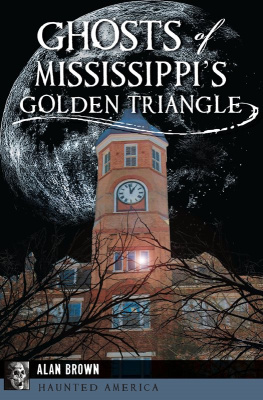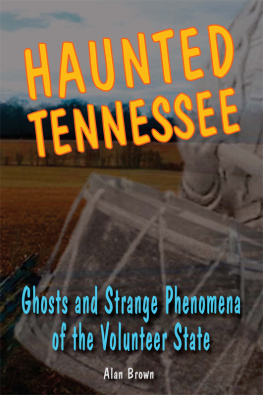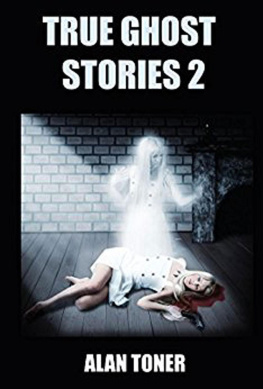Published by Haunted America
A Division of The History Press
Charleston, SC 29403
www.historypress.net
Copyright 2009 by Alan Brown
All rights reserved
All images courtesy of the author unless otherwise noted.
First published 2009
e-book edition 2012
ISBN 978.1.61423.374.9
print edition ISBN 978.1.59629.614.5
Library of Congress CIP data applied for.
Notice: The information in this book is true and complete to the best of our knowledge. It is offered without guarantee on the part of the author or The History Press. The author and The History Press disclaim all liability in connection with the use of this book.
All rights reserved. No part of this book may be reproduced or transmitted in any form whatsoever without prior written permission from the publisher except in the case of brief quotations embodied in critical articles and reviews.
CONTENTS
INTRODUCTION
The city of Birmingham, Alabama, has gone by a number of names since its founding in 1871 as an industrial enterprise. The presence of all of the raw materials required in the making of steeliron ore, coal and limestonemade it an ideal location for the steel industry. Named after one of Englands principal industrial cities, Birmingham soon became the greatest industrial center in the Southeast, earning it the nicknames The Pittsburgh of the South and The Magic City. The citys growth slowed down somewhat as a result of the cholera epidemic and the Depression of 1873, but it picked up again within a few years. By the turn of the century, Birmingham was known as The Song of the South as a result of the growth of its downtown section. A cluster of four office buildings constructed at the intersection of Twentieth Street and First Avenue North in 1912 was called The Heaviest Corner of the Earth. Growth halted during the Great Depression, although New Deal programs did fund the construction of Vulcan Park, where the symbol of Birminghams iron and fuel industrya fifty-five-foot-tall statue of the Roman god of the forgetowers over the city. The demand for steel during World War II gave Birmingham a much-needed economic boost. Birmingham once again seemed to be a city on the rise. However, an explosion in the Sixteenth Street Baptist Church in 1964, in which four African American girls died, earned the city the derogatory nickname Bombingham. In the 1970s, the construction of the University of Alabama Medical Center, the growth of the citys banks and the construction of several new skyscrapers inspired the visitors bureau to label Birmingham the diverse city.
Today, the city is rapidly acquiring a new handle, thanks in large part to the burgeoning interest in the citys haunted sites. The appearance of the Sloss Furnaces on nationally televised programs like Scariest Places on Earth in the 1990s has lured hundreds of paranormal investigators to the city. Other places where paranormal activity has been reported, like the Linn Henley Building and the Tutwiler Hotel, have been covered in the local media for years.
Still, Birminghams ghost lore is not nearly as rich as that found in much older cities, such as New Orleans, Charleston and Savannah. Consequently, I have been forced to expand the scope of the book to include Columbiana, Jasper, Bessemer and Montevallo, which are, in a sense, bedroom communities of Birmingham. These areas have provided me with a number of wonderfully bizarre tales, which are just as unsettling as the stories found in the city proper. Montevallo is an especially rich source of ghost stories because of its violent Civil War history.
At the time of this writing, the tag line Alabamas Most Haunted City has not yet been applied to Birmingham, at least not in the mind of the general public. This development is due in part to the fact that not all of the citys haunted places are willing to exploit their haunted reputations. It is the fond hope of this writer that as more and more people visit the city because of its haunted sites, Birmingham will learn to embrace its connection to the world of the paranormal.
BESSEMER
BESSEMERS HAUNTED HALL OF HISTORY
The city of Bessemer was founded by Henry F. DeBardeleben in 1887. Like nearby Birmingham, Bessemer had the raw materials required for the production of iron very close by: iron ore, coal and limestone. A network of railways had to be created to transport the raw materials in and out of the area. By 1900, Bessemer had four major railroads. Construction of Bessemers terminal was completed in March 1916 at a cost of $30,000, mostly by railroad personnel to save the cost of hiring an architect. The building, which still stands at 1905 Alabama Avenue, is 170 feet long and 50 feet wide. The exterior walls are made of pressed brown brick; the interior walls are coated with a wainscoting of terrazzo, which consists of marble chips randomly placed in cement. All of the woodwork is hand-finished heart pine and walnut. Glue was put on the windows and dried to create designs. The terminal had two waiting rooms: a waiting room for colored passengers on the left side and a waiting room for white passengers on the right. The depot also had a separate waiting room for white ladies. The segregated restrooms contained a total of eleven toilets. The terminal was well known for its state-of-the-art vapor heating system, the only one of its kind south of the Ohio River.
In 1973, the terminal was placed on the National Register of Historic Places. In 1985, the Bessemer Hall of History, which had been originally started by the Bessemer Junior Service League in the basement of the old post office, was moved to the old train terminal. Even though the old depot has been put to a different use, its appearance has changed very little since its construction in 1916. Some of the patrons and museum personnel believe that the spirit of one of the exhibits is still there as well.
In the minds of many citizens of Bessemer, the Hall of History will forever be connected to Hazel Farris. At the turn of the century, she was an attractive young woman who was fully aware of the effect her beauty had on men. Dominga N. Toner, director of the Bessemer Hall of History, said that Hazel was from the other side of the tracks, pretty rough and rowdy. In 1905, twenty-five-year-old Hazel was married and living in Louisville, Kentucky. According to contemporary accounts, on August 6, 1905, Hazel strode into the living room and told her husband that she wanted to buy a new hat. He told her no, and Hazel and her husband began to beat each other with their fists. After a minute or so of fierce fighting, Hazel pushed herself away from her husband, pulled out a pistol and shot him twice. Because both Hazel and her husband were known to drink heavily on occasion, the authorities who investigated the crime later on suspected that alcohol might have fueled their anger. Alerted by the sound of gunfire, Hazels neighbors alerted the police. Three passing police who heard the gunfire ran inside Hazels house. Three more gunshots resonated through the neighborhood. When the smoke cleared, all three policemen were dead. A few minutes later, a deputy sheriff entered the house by the back door and grasped Hazel from behind. In the struggle, his gun discharged, taking off her ring finger from her right hand. Hazel spun around and fired her pistol, making the deputy sheriff the fifth victim of her uncontrollable rage. The mystery surrounding a young womans ability to shoot and kill five lawmen is heightened by the fact that records show that no police officers were slain in Louisville on August 5, 1905.








